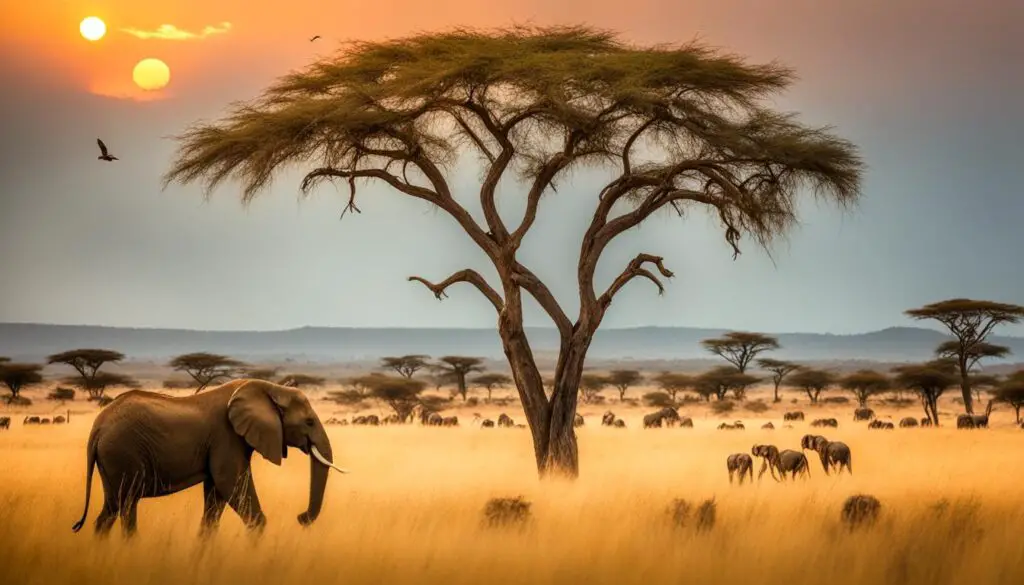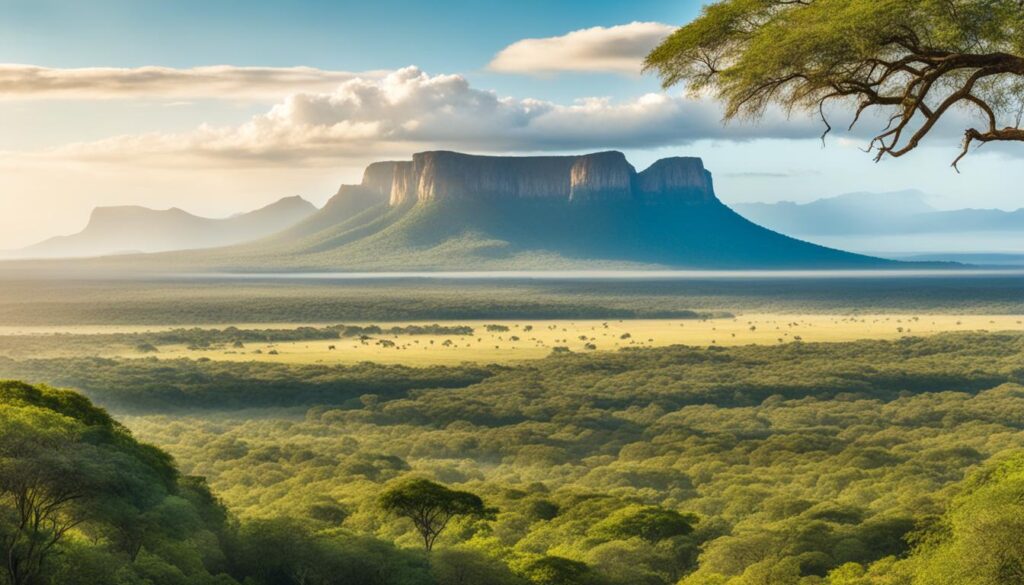Did you know that Mozambique is teeming with a remarkable array of animals? From massive mammals to magnificent birds, this Southeast African country is a paradise for wildlife enthusiasts and safari adventurers. With over 236 species of mammals, 740 species of birds, and a staggering 5,692 species of vascular plants, Mozambique boasts an unparalleled level of biodiversity that will leave you in awe.

Key Takeaways:
- Mozambique is home to a diverse range of animal species, including 236 mammal species and 740 bird species.
- The country’s high levels of biodiversity make it an ideal destination for wildlife enthusiasts and nature lovers.
- With over 5,600 recorded plant species, Mozambique boasts an impressive variety of flora as well.
- Endangered species such as African wild dogs and leatherback turtles can also be found in Mozambique.
- Protected areas, including national parks and reserves, play a crucial role in conserving Mozambique’s unique wildlife.
Geography of Mozambique
Mozambique, located on the southeast coast of Africa, is surrounded by Eswatini, South Africa, Zimbabwe, Zambia, Malawi, Tanzania, and the Indian Ocean. The country’s geography is diverse, with a variety of topographical features that make it a unique destination.
The topography of Mozambique can be divided into two distinct regions by the Zambezi River. In the northern part of the country, you’ll find coastal areas, inland hills, plateaus, and rugged highlands. These natural landscapes offer breathtaking views and opportunities for exploration.
Mozambique experiences a tropical climate, characterized by distinct wet and dry seasons. The wet season lasts from October to March, bringing heavy rainfall to the region. The dry season, on the other hand, occurs from April to September, with less precipitation and warmer temperatures.
Exploring Mozambique’s geography allows visitors to discover its stunning coastal areas, scenic hills, and diverse ecosystems. Whether you’re a nature enthusiast or simply looking to experience the beauty of this African nation, Mozambique offers a captivating landscape to explore.
Flora of Mozambique
Mozambique boasts a diverse range of flora, with various vegetation types found across the country. The majority of Mozambique is covered by wooded savanna, characterized by grasslands interspersed with scattered trees. These savannas support a remarkable array of plant species, contributing to the country’s rich biodiversity. Here are some notable vegetation types and plant species found in Mozambique:
Miombo Woodland
Miombo woodland is the dominant vegetation type in the northern region of Mozambique. It is characterized by open, woodland areas with tall trees, such as Brachystegia and Julbernardia species. Miombo woodlands are highly diverse and provide habitat for a variety of wildlife species, including elephants, antelopes, and primates.
Mangroves in Mozambique
Along the coastal areas of Mozambique, you’ll find extensive mangrove forests covering approximately 400,000 hectares. These mangroves play a vital role in protecting the shoreline and acting as nurseries for various marine species. The mangroves provide habitat for unique plant species, such as Avicennia and Rhizophora, which have adapted to thrive in saline environments.
Forest Cover
While the majority of Mozambique is characterized by savanna and woodland, forest cover is limited to specific areas. Forests are found on the upper slopes of mountains, such as Mount Namuli and Mount Mabu, as well as in coastal regions. These forests harbor a diverse range of tree species, including indigenous hardwoods and rare endemic plants.
Overall, Mozambique’s flora is incredibly diverse, with over 5,600 plant species recorded in the country. This remarkable plant diversity contributes to the overall ecological balance and supports the diverse wildlife found in Mozambique.

| Vegetation Type | Key Characteristics | Representative Species |
|---|---|---|
| Miombo Woodland | Open woodland with tall trees | Brachystegia, Julbernardia |
| Mangroves | Growing along the coast | Avicennia, Rhizophora |
| Forest | Upper mountain slopes and coastal areas | Indigenous hardwoods, endemic plants |
Fauna of Mozambique
Mozambique is renowned for its diverse and captivating wildlife. The country is home to an impressive array of fauna, including:
1. Mammals
Mozambique boasts a remarkable variety of mammalian species, with 236 recorded in the country. These include iconic African animals such as elephants, lions, leopards, cheetahs, and giraffes. The lush habitats of Mozambique provide a sanctuary for these majestic creatures.
2. Birds
Mozambique is a bird lover’s paradise, with more than 740 species of birds found within its borders. From vibrant tropical birds to powerful raptors, the avian diversity in Mozambique is awe-inspiring. Birdwatchers and nature enthusiasts can delight in spotting rare and beautiful species as they explore the country’s diverse habitats.
3. Reptiles, Amphibians, and Marine Life
In addition to mammals and birds, Mozambique is home to a rich variety of reptiles, amphibians, and marine life. From crocodiles and turtles to frogs and snakes, the country’s ecosystems support a diverse range of these fascinating creatures. The coastal waters of Mozambique are also teeming with marine life, offering opportunities for snorkeling and diving enthusiasts to observe colorful fish, dolphins, and even migrating whales.
Mozambique’s commitment to conservation has helped protect and preserve its remarkable wildlife. However, the country also faces challenges, particularly in safeguarding endangered species.
Endangered Species in Mozambique
Mozambique is home to several endangered species that require special attention and conservation efforts. Some of the endangered species found in Mozambique include:
- African Wild Dogs
- Leatherback Turtles
- Pangolins
- Black Rhinoceros
- Niassa Wildebeest
Protecting these vulnerable species is crucial for maintaining the biodiversity and ecological balance of Mozambique’s wildlife. Efforts are being made to raise awareness, enforce regulations, and establish protected areas to ensure the survival of these endangered species.
Protected Areas in Mozambique
Mozambique is committed to preserving its rich natural heritage through the establishment of protected areas. These areas serve as havens for diverse ecosystems and wildlife, contributing to wildlife conservation efforts and promoting sustainable tourism.
Currently, Mozambique boasts an impressive network of protected areas, encompassing a combination of national parks, reserves, and other conservation areas. These protected areas cover approximately 15% of the country’s surface area, safeguarding Mozambique’s unique flora and fauna.
Among the notable protected areas in Mozambique are:
- Gorongosa National Park: Located in the central part of the country, Gorongosa National Park is a wildlife paradise. It is home to a variety of animal species, including lions, elephants, zebras, and hippos. The park’s diverse landscapes, encompassing grasslands, woodlands, and wetlands, provide a thriving habitat for wildlife.
- Niassa National Reserve: Situated in the northern part of Mozambique, Niassa National Reserve is one of Africa’s largest protected areas. This expansive reserve spans over 42,000 square kilometers and is renowned for its remarkable biodiversity. Visitors can encounter impressive wildlife, such as elephants, lions, leopards, and endemic bird species.
- Maputo Special Reserve: Located in the south of Mozambique, near the capital city of Maputo, the Maputo Special Reserve offers a unique coastal wilderness experience. This protected area encompasses a diverse range of habitats, including mangrove swamps, dunes, and wetlands. Visitors can observe a variety of wildlife, including antelopes, crocodiles, and an array of bird species.
Efforts are underway to restore and rehabilitate these protected areas following the challenges faced during the civil war and instances of poaching. Conservation initiatives, including anti-poaching patrols and community engagement programs, are essential for the long-term sustainability and success of wildlife conservation in Mozambique.
Wildlife Tourism in Mozambique
Mozambique is emerging as a popular destination for wildlife tourism, offering visitors the opportunity to experience the country’s rich biodiversity and diverse ecosystems. With its stunning landscapes and unique wildlife encounters, a trip to Mozambique promises an unforgettable adventure.
One of the main attractions for wildlife enthusiasts is the chance to explore Mozambique’s national parks and reserves, which are home to a wide range of fascinating species. From majestic elephants to graceful zebras, playful dolphins to ancient turtles, and even awe-inspiring whales, there is no shortage of wildlife to admire.
When it comes to wildlife tourism in Mozambique, some notable destinations stand out. Gorongosa National Park, located in the central part of the country, is known for its incredible wildlife sightings and stunning natural landscapes. Visitors can embark on exhilarating safari trips to spot large herds of elephants, graceful antelopes, and an abundance of birdlife.

Niassa National Reserve, situated in the northernmost part of Mozambique, is home to one of the largest remaining elephant populations in Africa. Travelers can witness these magnificent creatures in their natural habitat, along with other wildlife such as lions, leopards, and buffalo.
For those interested in marine life, the Ponta do Ouro Partial Marine Reserve on the southeastern coast of Mozambique offers exceptional opportunities for snorkeling and diving. It is renowned for its vibrant coral reefs and the chance to encounter dolphins, turtles, and a variety of fish species.
Wildlife tourism in Mozambique provides not only the chance to witness remarkable animals but also contributes to the conservation efforts in the country. By supporting eco-tourism initiatives, visitors contribute to the preservation of Mozambique’s delicate ecosystems and the protection of its wildlife.
Whether you’re seeking a memorable safari adventure or a unique marine wildlife encounter, Mozambique has something to offer every nature enthusiast. Plan your trip to Mozambique and immerse yourself in the beauty of its wildlife reserves, where incredible encounters with nature await.
Unique Wildlife Experiences in Mozambique
Mozambique offers a wide range of unique wildlife encounters and experiences that allow visitors to immerse themselves in the country’s diverse natural wonders. From the breathtaking sight of sea turtles nesting along the coast to thrilling ocean safaris to spot dolphins and migrating whales, Mozambique provides unparalleled opportunities for wildlife enthusiasts.
One of the most elusive marine mammals found in Mozambique is the dugong. These rare creatures, often referred to as “sea cows,” can be observed in their natural habitat, gracefully gliding through the crystal-clear waters. Witnessing a dugong in Mozambique is a truly extraordinary and unforgettable experience.
Another remarkable wildlife encounter awaits on Inhaca Island, where vibrant birdlife flourishes amidst the lush vegetation. Nature enthusiasts can observe and photograph a variety of bird species, including the striking lilac-breasted roller and the magnificent palm-nut vulture.
For those seeking a thrilling underwater adventure, snorkeling off the coast of Tofo Beach is a must. Dive into the pristine waters and encounter the majestic whale sharks and graceful manta rays that call Mozambique’s marine ecosystem home. Swimming alongside these gentle giants is an awe-inspiring experience that will leave a lasting impression.
Conclusion
Mozambique’s rich biodiversity and diverse wildlife make it a captivating destination for nature lovers and wildlife enthusiasts. The country’s protected areas, including national parks, reserves, and conservation areas, play a crucial role in conserving Mozambique’s unique species and habitats.
Efforts to rehabilitate and restock these protected areas have yielded positive results, contributing to the conservation of endangered species and the preservation of Mozambique’s natural heritage. As a result, wildlife populations have stabilized and even increased in some areas.
Wildlife tourism in Mozambique is on the rise, attracting visitors from around the world who are eager to experience the country’s stunning landscapes and engage in unforgettable wildlife encounters. From exploring the vast plains of Gorongosa National Park to diving with whale sharks off the coast of Tofo Beach, Mozambique offers a truly authentic African adventure.
It is important to recognize the significance of wildlife conservation in Mozambique. The preservation of the country’s wildlife not only helps to maintain balanced ecosystems but also contributes to the local economy through sustainable tourism. By supporting wildlife conservation efforts, we can ensure that future generations can continue to enjoy the beauty and wonder of Mozambique’s natural treasures.
